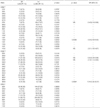1. Lee WM. Hepatitis B virus infection. N Engl J Med. 1997. 337:1733–1745.

2. Iino S. Natural history of hepatitis B and C virus infections. Oncology. 2002. 62:Suppl 1. 18–23.

3. Lok AS, McMahon BJ; Practice Guidelines Committee, American Association for the Study of Liver Diseases. Chronic hepatitis B. Hepatology. 2001. 34:1225–1241.

4. Jung MC, Pape GR. Immunology of hepatitis B infection. Lancet Infect Dis. 2002. 2:43–50.

5. Urbani S, Boni C, Amadei B, Fisicaro P, Cerioni S, Valli MA, Missale G, Ferrari C. Acute phase HBV-specific T cell responses associated with HBV persistence after HBV/HCV coinfection. Hepatology. 2005. 41:826–831.

6. Davenport MP, Quinn CL, Chicz RM, Green BN, Willis AC, Lane WS, Bell JI, Hill AV. Naturally processed peptides from two disease-resistance-associated HLA-DR13 alleles show related sequence motifs and the effects of the dimorphism at position 86 of the HLA-DR beta chain. Proc Natl Acad Sci USA. 1995. 92:6567–6571.

7. Lee DH, Kim JH, Nam JJ, Kim HR, Shin HR. Epidemiological findings of hepatitis B infection based on 1998 National Health and Nutrition Survey in Korea. J Korean Med Sci. 2002. 17:457–462.

8. Ahn SH, Han KH, Park JY, Lee CK, Kang SW, Chon CY, Kim YS, Park K, Kim DK, Moon YM. Association between hepatitis B virus infection and HLA-DR type in Korea. Hepatology. 2000. 31:1371–1373.

9. Hwang SH, Sohn YH, Oh HB, Hwang CY, Lee SH, Shin ES, Lee KJ. Human leukocyte antigen alleles and haplotypes associated with chronicity of hepatitis B virus infection in Koreans. Arch Pathol Lab Med. 2007. 131:117–121.

10. Miller SA, Dykes DD, Polesky HF. A simple salting out procedure for extracting DNA from human nucleated cells. Nucleic Acids Res. 1988. 16:1215.

11. Kotsch K, Wehling J, Blasczyk R. Sequencing of HLA class II genes based on the conserved diversity of the non-coding regions: Sequencing based typing of HLA-DRB genes. Tissue Antigens. 1999. 53:486–497.

12. Van der Zwan A, Griffith B, Rozemuller E, Williams T, Tilanus MG. Tilanus MGJ, Hansen JA, Hurley CK, editors. Sequence-based typing for HLA-DQB1 strategy for ABI sequencing equipment. IHWG Technical Manual. 2000. Seattle: International Histocompatibility Working Group;TM12A1–TM12A4.
13. Van der Zwan A, Rozemuller E, Tilanus MG. Tilanus MGJ, Hansen JA, Hurley CK, editors. Sequence-based typing for HLA-DPB1 strategy for ABI equipment. IHWG Technical Manual. 2000. Seattle: International Histocompatibility Working Group;TM14A1–TM14A4.
14. Stephens M, Smith NJ, Donnelly P. A new statistical method for haplotype reconstruction from population data. Am J Hum Genet. 2001. 68:978–989.

15. Lee KW, Oh DH, Lee C, Yang SY. Allelic and haplotypic diversity of HLA-A, -B, -C, -DRB1, and -DQB1 genes in the Korean population. Tissue Antigens. 2005. 65:437–447.

16. Thursz MR, Kwiatkowski D, Allsopp CE, Greenwood BM, Thomas HC, Hill AV. Association between an MHC class II allele and clearance of hepatitis B virus in the Gambia. N Engl J Med. 1995. 332:1065–1069.

17. Höhler T, Gerken G, Notghi A, Lubjuhn R, Taheri H, Protzer U, Löhr HF, Schneider PM, Meyer zum Büschenfelde KH, Rittner C. HLA-DRB1*1301 and *1302 protect against chronic hepatitis B. J Hepatol. 1997. 26:503–507.

18. Thio CL, Thomas DL, Karacki P, Gao X, Marti D, Kaslow RA, Goedert JJ, Hilgartner M, Strathdee SA, Duggal P, O'Brien SJ, Astemborski J, Carrington M. Comprehensive analysis of class I and class II HLA antigens and chronic hepatitis B virus infection. J Virol. 2003. 77:12083–12087.

19. Diepolder HM, Jung MC, Keller E, Schraut W, Gerlach JT, Grüner N, Zachoval R, Hoffmann RM, Schirren CA, Scholz S, Pape GR. A vigorous virus-specific CD4+ T cell response may contribute to the association of HLA-DR13 with viral clearance in hepatitis B. Clin Exp Immunol. 1998. 113:244–251.
20. Cao T, Desombere I, Vanlandschoot P, Sallberg M, Leroux-Roels G. Characterization of HLA DR13-restricted CD4(+) T cell epitopes of hepatitis B core antigen associated with self-limited, acute hepatitis B. J Gen Virol. 2002. 83:3023–3033.

21. Van Hattum J, Schreuder GM, Schalm S. HLA antigens in patients with various courses after hepatitis B virus infection. Hepatology. 1987. 7:11–14.

22. Begovich AB. HLA-DPA1, -DPB1, DQA1, and -DQB1 allele frequencies in a population from Gambia. Hum Immunol. 2004. 65:944–945.

23. Thio CL, Carrington M, Marti D, O'Brien SJ, Vlahov D, Nelson KE, Astemborski J, Thomas DL. Class II HLA alleles and hepatitis B virus persistence in African Americans. J Infect Dis. 1999. 179:1004–1006.

24. Jiang YG, Wang YM, Liu TH, Liu J. Association between HLA class II gene and susceptibility or resistance to chronic hepatitis B. World J Gastroenterol. 2003. 9:2221–2225.

25. Almarri A, Batchelor JR. HLA and hepatitis B infection. Lancet. 1994. 344:1194–1195.

26. Yang G, Liu J, Han S, Xie H, Du R, Yan Y, Xu D, Fan D. Association between hepatitis B virus infection and HLA-DRB1 genotyping in Shaanxi Han patients in northwestern China. Tissue Antigens. 2007. 69:170–175.

27. Milner CM, Campbell D, Trowsdale J. Lechler R, Warrens A, editors. Molecular genetics of the human major histocompatibility complex. HLA in health and disease. 2000. London: Academic press;35–50.








 PDF
PDF ePub
ePub Citation
Citation Print
Print


 XML Download
XML Download